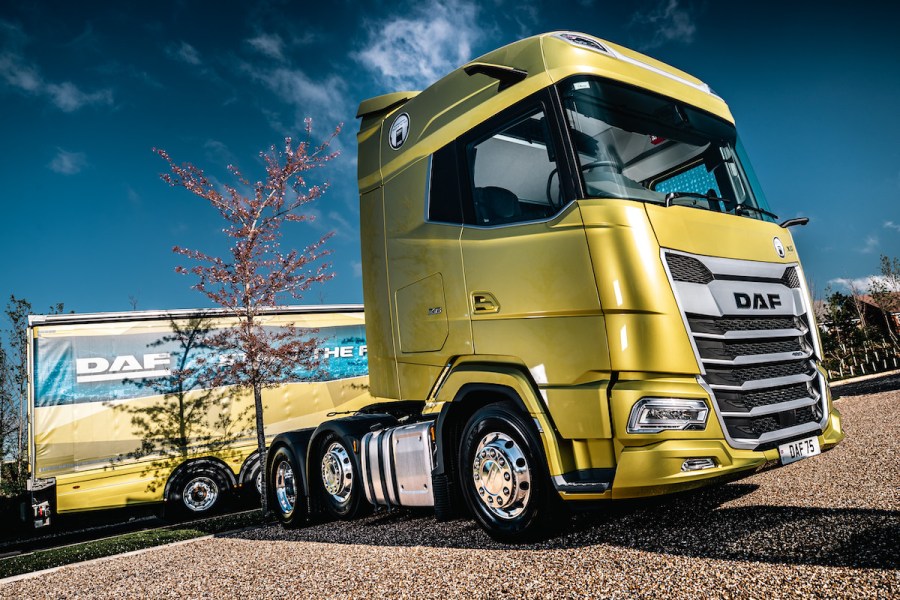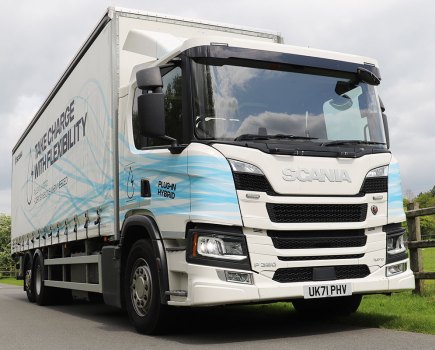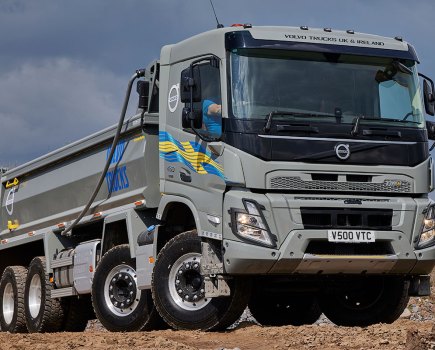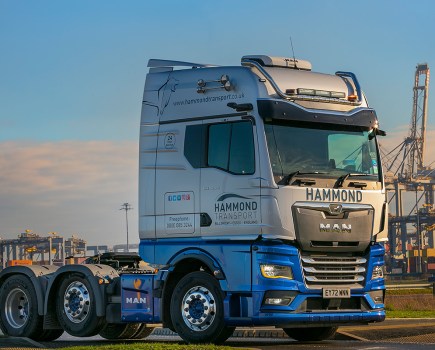Trucking took a right-hand drive DAF XG480 out for a day and a night to see if the bigger cab really does make a difference…
Good things come to those who wait. After years of mickey-taking from some journals and drivers about how old the DAF XF cab was, it’s finally been replaced.
The new models – a new XF, the XG and the XG+ – were launched last year. A ride-and-drive event in Spain was our first chance to sample the trucks (Trucking, November 2021), but they tend to be shorter trips – and of course in European models spec’d for left-hand drive. What Trucking really wanted was a long stint in a right-hand drive model in the UK. And in late March, we got just that.
First up, a massive amount of praise to DAF for the truck we had. It wasn’t the all-singing, all-dancing XG+ with 530 bhp engine, leather seats and every option box ticked. It was an XG480 with a standard interior spec – the kind of truck that realistically is going to be the more (if not most) popular deals agreed by the salesmen.
The XG+530 may be the truck owner-drivers and small fleets want the most, but typical fleet operators will most probably go for the XF480 or possibly the XG480.
For our test, we were given an XG with middle-of-the-range MX13 engine delivering 480 bhp and a pretty standard interior with cloth trim.
But as well as giving it a decent 170-mile workout over all manner of UK roads, we also had a night sleeping in it. So many drivers sleep in their cabs, so knowing what kind of night you can expect to have when parked is just as important as how the vehicle handles on the A34.
Technical overview
Before we get onto the specifics of this truck, a brief reminder of the new vehicles DAF unveiled last year. The ‘entry level’ model is the XF, which is pretty much the same in size and spec as an XF Space Cab today. It’s a high-roof sleeper and will appeal to fleets and those whose drivers are doing odd nights out, but not necessarily tramping.
It is 16 cm longer than the outgoing XF cab due to its bigger front end. There is currently no flat-roof version, although DAF has hinted this might not always be the case.
Next is the XG, and this is the game-changer. The XG offers 33 cm extra length over the 2017 XF models. Crucially, that means the bed is wider – its width is now 80 cm, the same as a standard single bed you’d have at home. The extra cab length is thanks to new dimensions for HGVs adopted by the EU in September 2020 (and finally signed off in the now-divorced UK in February of this year).
The new dimensions allow longer cabs to enable manufacturers to make their vehicles more aerodynamic and have better crumple zones. But while DAF has done both of those, it has also exploited the extra length to allow a longer, usable cab for the driver. We are not talking US-style huge sleeping areas, but the extra length is very noticeable – especially inside.
Then there is the XG+, which is the same length as the XG, but higher by a good few cm. Interestingly, the XG is as high as the older Super Space Cab, so you get an idea of how cavernous the XG+ is! It’s massive.
The drivelines are pretty much as they were before. For tractor units, you can choose the 10-8-litre MX11 straight-six at 410 and 450 bhp, or the 12.9-litre MX13 at 430, 480 and 530 bhp. But there have been more tweaks to the engines, especially in upping the all-important torque ratings.
Understandably, DAF is still refusing to break the 600 bhp barrier, although many hauliers have hinted 560, 570 or 580 bhp output would win it a few more orders. If there was an XG+580, it would sell – no question.
Axle options
The truck we had was an XG480 FTG, which means it has a non-steering midlift axle and will likely be DAF’s best seller. XF, XG and XG+ models are available with a small midlift (FTP), a rear tag (FTR), a rear-steer tag (FTN), or a twin-tyred rear tag (FTS), as well as a 4×2 (FT) of course. The FT can also be a low-height spec. Following later this year will be 6×4 and 8x4s.
The engine in our truck was an MX13 delivering 483 bhp at 1600 rpm, and 2500 Nm of torque between 900-1125 rpm. It meets Euro 6D emission regulations. The gearbox is an automated TraXon 12-speed. Some drivers have been critical of this ’box, citing it as unresponsive and slow to change gears; but DAF says it is much improved.
It is fitted with a manoeuvring mode for maximum power control which, if selected, means the clutch engages gradually and proportionally to the accelerator pedal, which helps smooth out gearchanges.
The truck has a three-stage engine brake which is also much improved and far more effective than before. The tyres were 315/70R22.5 throughout and the front axle was the typical rating of 8000 kg, with an 11,500 kg drive axle and a 6500 kg non-steering midlift centre axle.
And the other big highlight of the new truck was DAF’s Digital Vision System (DVS), which replaces the wing mirrors. The obvious question is: will it be better an Merc’s pioneering MirrorCam? We’ll get to that shortly…
On the road
To say we were keen to get behind the wheel of an RHD New DAF XG was an understatement. It was, at last, a chance to see what these trucks are like on UK roads, and to a UK spec. But also, we were keen to see how DAF’s DVS fared.
The new XF/XG models have a tough act to follow because despite their age, the outgoing XF is still a widely regarded truck, popular with drivers and operators alike. But by starting with the clichéd ‘blank sheet of paper’, DAF has been able to address the shortcomings of the old model.
You see this the moment you enter the cab via its three steps. For a start, the steering wheel has a useful adjustable movement; something that was not the case on the old truck. You can fold it well out of the way to make entry and exit easier. Of course, this is nothing new – other manufacturers have been offering this for several years. Now DAF has caught up.
The driving position is certainly comfortable enough. The dash has been upgraded and is more user friendly. It’s a digital dash, with a choice of settings to suit different drivers. It’s not quite the same as the Merc, but it is excellent and also feels more like a dash than a tablet. The steering wheel now has more buttons that are of use to the driver, reducing the need to take your hands off the wheel. It’s especially easy to set the cruise control.
Visibility from the large, curved windscreen is superb. It’s some 33 per cent bigger than the current XF’s, which gives the driver a vastly superior view of the road and gives the truck a Direct Vision Standard rating of three stars, even without a passenger door window.
Ride & handling
The ride quality of the XG480 is superb. Steering is much improved. We often found the old DAFs had a bit of give (or rattle) in the steering column, but we found no such thing on this drive. The truck went exactly where we wanted and expected it to.
On single-carriageway roads with plenty of bends, it was a dream to drive. It never ran away from us when going down hills, and the descent of the two-mile Stokenchurch hill was extremely comfortable, even fully loaded, thanks to the improved engine brake.
The route we took from DAF’s base at Haddenham was the A418 to Oxford, skirting round the university city to take the A420 towards Swindon, and then onto the M4 at Junction 13 to the Chippenham Pitstop for a lunch break.
The return was along the M4 to Reading, then up the A404 bypassing Marlow to join with the M40 for a couple of junctions before heading off for some cross-country driving back to Haddenham – a good workout for the truck, and the driver.
We weren’t doing a fuel test, but we did happen to notice on the stretch along the M4 on the return, the dash was showing an incredible 14.75 mpg. Early reports from operators suggest the new models are indeed delivering sizable improvements in fuel consumption.
Of course, it’s horses for courses and no two drives are the same; but if you can get 12 or 13 mpg consistently from motorway driving with the new models, any operator will be over the moon with that.
Overnight
After a decent stint behind the wheel, it was time to bed down for the night. First up, the ambience inside the cab was amazing. Remember, this is fleet-spec with cloth seats (which some prefer, although leather seats are easier to clean), but the quality was top rate.
This was a lovely place to work. The XG is slightly lower in overall height than the XG+, but still pretty much the same height as a current Super Space Cab. It is, however, the same height off the ground as an XG+. This means a tall person of over 6 ft can easily stand up to get changed.
There is the slightest of engine humps (just 5 cm), so nothing to worry about. Some drivers don’t like completely flat floors because of dirt and dropped pens or whatever rolling around. This cab oozes class and it’s a definite improvement on the outgoing models. Moving around the cab is dead easy.
We’d recommend when you park up for the night, you spend a few minutes ‘rearranging’ the furniture to make optimum use of the space. Both seats swivel, which creates a lounge-type feel in the cab – the vast amount of room opens up even more.
However, make sure you then push the seats back as far as they will go and keep them relatively upright. This not only maximises space, but also allows access to the under-bunk fridge and/or freezer. If you don’t push the seats back, we found they won’t slide out fully!
There is a pull-out table for your laptop or free-standing TV, but it’s also usable to prepare and eat food. Unlike on some other trucks, this table is actually sturdy.
Interior lighting is excellent and can be adjusted to suit your tastes. Maybe you want full lighting to do some work, or mood lighting to watch telly, or fading lighting to nod-off to. It’s all possible with this new system.
Good night’s sleep
The bed is superb and after a long day behind the wheel, having a mattress as comfortable and flexible as this is a dream come true. It’s very thick, but also has a mattress topper which makes it even more luxurious. The bed is adjustable via two buttons on the frame; it’s a bit like a hospital bed, as you can angle it. This makes watching telly even better if, like many drivers, you have a TV fixed to the side wall of the cab. It makes it like a lounger and it’s great for a power nap, a TV session, or if you just prefer a bit of height at one end when you sleep.
Once we’d settled in for the night, it was time to get some shut-eye. Despite being the last day of March, it was a bitterly cold night and the night heater did its job – a bit too well, as it happens, as by 2 am we were being cooked alive. So we tried to turn it down, but only succeeded in turning it off, such that two hours later we woke up freezing! The heater controls were on the dash, but due to a software issue there was no way to turn the heart on, off, up or down using the panel by the bed.
We won’t criticise the DAF for that; but if you buy one, make sure you can do all of those things. The bed itself was incredibly comfortable to sleep on and honestly, if we could have unscrewed it and taken it home, we would have.
Overall, this cab is a million times better than the old Super Space, and probably the best currently on the market. It’s roomy, well-thought-out and the quality is exemplary. It’s a great place to work, and an even better place to live in.
DAF Digital Vision System
One of the best new features on the XG has to be the Digital Vision System. We’re fans of digital mirrors. We agree they are not perfect, but neither are traditional wing mirrors – and we feel digital mirrors have more pluses than minuses.
On the DAF, they are superb. The images are clear, the screens are a sensible size and well positioned and, unlike Mercedes, all mirrors have been replaced – including the front and door mirrors. DVS comes into its own when reversing, especially while turning – for example, during those tricky and tight manoeuvres onto loading bays.
Merc, MAN, DAF and Scania have all now shown off their new systems (Iveco and Renault have pretty much confirmed they are on the way). This just leaves Volvo, which is kind of ironic given the Swedish manufacturer’s reputation as a leader in safety innovations.
Of course, digital mirrors take a bit of getting used to, but they are the future – and it feels like DAF has got it right with this system.
VERDICT
It’s obvious there were only so many makeovers and facelifts DAF could get away with on the old Cabtec cab. It was still good, but the competition had all overtaken it – including those brands which DAF would be traditionally more likely to be vying with for market share.
DAF is the first truck manufacturer to exploit the change in cab dimension legislation. Already the truck is selling well and the reports we’ve seen from drivers suggest most are happy.
DAF has improved every aspect of the design. Its decision to go with digital mirrors is the right one. Its dash is better thought out and much easier to use. The XG handles well, performs well, and it is a high-spec truck with excellent build quality. It’s appearance might take a bit of getting used to, but we’ve already seen some painted in nice liveries and they look the part.
Add in DAF’s excellent dealer network and superb back-up, plus excellent fuel returns, and it’s impossible to see how this truck will not keep the manufacturer at the top of the UK sales charts for several years to come.
This truck is truly superb.
Likes:
+ The superb bed!
+ Digital Vision System
+ Improved fascia
+ Lots of storage space
Dislikes:
– Lack of a 580 bhp model
SPECIFICATION
Model: DAF XG480 FTG
Design GCW: 44,000 kg
Chassis: 3950 mm wheelbase
Front axle: 8000 kg capacity
Rear axle: 11,500 kg (drive), 6500 (midlift), 2.21:1 ratio. 315/70R22 tyres
Gearbox: TraXon 12TX 2210 DD automated 12-speed
Engine: MX13 12.8-litre six-cylinder EGR
Max power: 483 bhp @ 1600 rpm
Max torque: 2500 Nm @ 900-1125 rpm
Cab: XG high-roof sleeper






